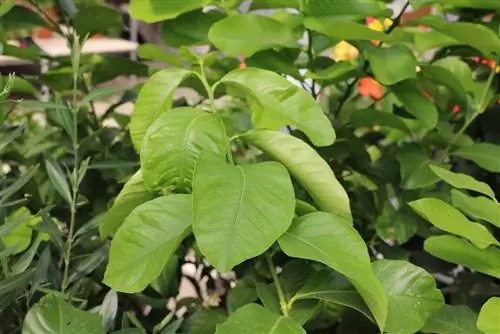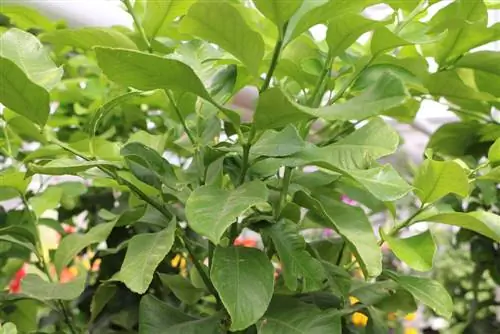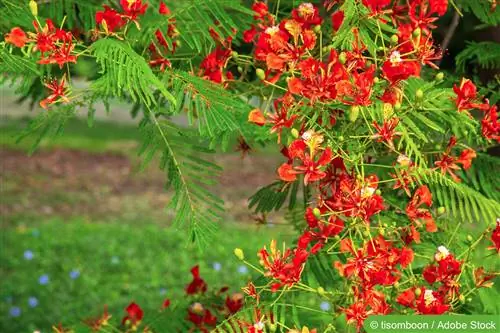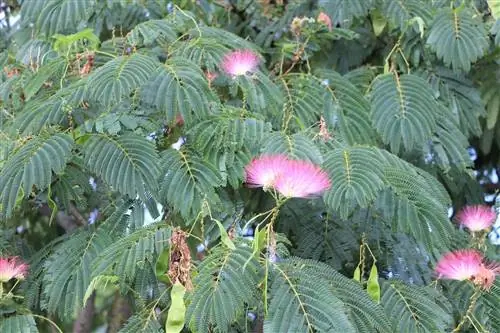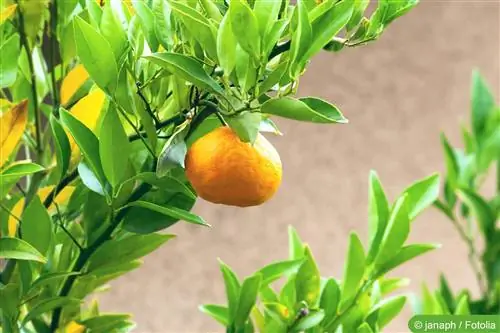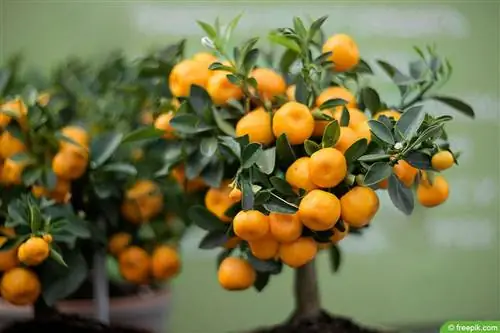- Author admin [email protected].
- Public 2023-12-17 03:39.
- Last modified 2025-01-24 12:45.
Mandarins are citrus fruits and the mandarin tree is a member of the rue family. The mandarin was first mentioned in China in the 12th century BC, so it is a very old plant. It also probably comes from the Chinese area or the northeast of India.
Today's mandarin, however, has its origins in the Mediterranean region. It is said to be a successor to the original mandarin variety. However, the “new” varieties are now found in all warm regions of the world and are no longer limited to the countries of origin. Your external characteristics:
- dark green, lanceolate leaves
- strong orange fruits
- white flowers
Most of the tangerine trees available in stores are grafted plants, they were grown through artificial propagation. The fruits of these tangerine trees are not edible. These ornamental trees can be planted in regular potting soil, to which fertilizer is then added regularly throughout the year. This is available commercially as a special citrus fertilizer that contains the right nutrient cocktail.
The location for the tangerine tree
If you have chosen a nice, sunny spot as a location for your tangerine tree, you are well advised. It not only needs enough light and sun, but also enough space, as it grows to a height of around 120 cm and can be very wide. Because of its origins in the Mediterranean region, it needs a lot of sun and warmth, which should be between 20°C and 27°C. The tangerine tree is not hardy, so it is best planted in a container and then brought into the house before the temperatures get cooler. If it is still quite cold in April or May and there is a risk of night frosts, the tangerine tree should only be planted outdoors later.
Tip:
A winter garden is suitable as a location all year round.
Caring for the tangerine tree and possible care mistakes
A tangerine tree may not be difficult to maintain, but mistakes can still occur. In most cases, they occur when too much water is given or poor drainage holds water in the soil for too long. This causes the roots to die and the fine fibrous roots to rot. As a result, the leaves initially become white, then the leaves curl up or do not grow. The loss of the beautiful green leaves is the next stage and then the tangerine tree switches to emergency. He also loses the fruit or stops developing it. In this case, repotting is the first aid.
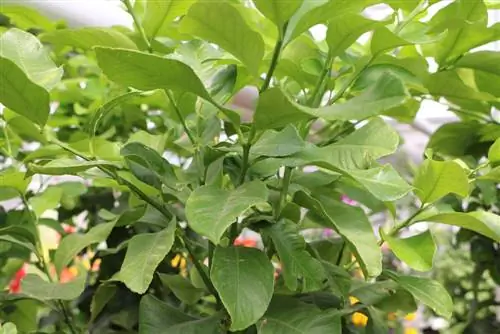
If there is frost damage, individual leaves turn brown or bronze. If the branches are not affected, the tree can recover again. If the fruits are frozen, they burst open or tear. During drought, the earth becomes far too dry and feels dusty. Then you can see that the plant has “dried up”. In this drought, you can try to save something by watering the plant in batches.
Location in winter
Before you buy a tangerine tree, you should plan the location for the winter. During this time it requires temperatures between 12°C and 14°C. Particularly if the parking space is the winter garden, attention should be paid to maintaining the temperatures. A winter garden that is not heated can quickly become too cold and the tangerine tree will drop its leaves and fruit. In the worst case, it can also die from the constant temperature difference between day and night. It is better to place it in a place where a low temperature can be maintained constantly.
Important:
The tangerine tree should be in winter quarters before the first drop in temperature!
If you were to expose it to strong differences in temperature, it would react in the same way by dropping its leaves. In winter quarters it is regularly supplied with water, and the fruits should also be removed during this time. By the way, the tangerine tree doesn't like constant changes of location; this can also lead to the loss of leaves. Ideally, it is watered with rainwater; small portions of water ensure that the soil never completely dries out. However, it should not be completely soaked; the roots need a slight moisture.
Variant 1: Bright and warm wintering
With this method, the tangerine tree is brought into the living area, where it remains in warm temperatures and as close to the window as possible throughout the winter. If necessary, you can also hang a plant lamp over it, which will then illuminate it for 10 hours a day.
Tip:
The brighter the light, the higher the room temperature.
When overwintering indoors, you should definitely check whether the mandarin tree's pot is just as warm. In many rooms, the area above the floor is colder than the area above, which is completely normal. Conversely, underfloor heating is not suitable for the pot to be placed on the floor immediately. In this case he should stand on a stool. In addition, a lack of humidity in heated rooms is a problem. To do this, a saucer can be filled with wet expanded clay, on which the flower pot with the tangerine tree is then placed.
Variant 2: Dark and cool wintering
If the tangerine tree is to overwinter in a cool room, it does not have to be bright. The temperatures can then be around 10°C. In this case, the tangerine tree needs less water than during warm wintering. However, great care should be taken to ensure that the pot is not too cold. If necessary, a bubble wrap can be placed around it. In any case, it is important that the plant is observed. This way you can quickly notice if something is missing and take action.
Pruning the tangerine tree
A mandarin tree does not necessarily have to be cut back in order to encourage stronger growth or the development of more flowers or fruits. If you want to cut back a tree like this, it's more so that the crown can grow nice and round. The best time for this is after winter rest. Repotting may then be necessary, but only if the root ball completely fills the pot. If it were rigorously cut back, the tree could suffer. A he althy tangerine tree should only be pruned to the extent to create a slight shape or to remove dead or diseased shoots. Only if it is infested with pests can it be cut back more extensively.
What you should know about the tangerine tree in brief
- Height up to 120 cm
- Width up to 60 cm
- Temperature 20 to 27°C
- direct sun
- Shrubs
Care
Citrus trees love direct sun and temperatures of 20 to 27°C. In warm weather, spray them with water every day. Watering occurs when the substrate surface is dry. The location should be well ventilated, but avoid drafts. On warm summer days, citrus trees also feel comfortable outdoors. During the rest period in winter, a temperature of around 13″C is recommended. Keep the substrate just moist enough to prevent it from drying out.
Propagation
Cuttings are taken and planted in summer. Seeds can also be sown.
Pests and diseases
Mealybugs cover the leaves and stems with white wax wool. Scale insects like to settle on the underside of leaves.
Genus
The representatives of the Citrus genus are only suppliers of tasty fruit such as oranges, lemons (lemon tree) or grapefruit, but enrich the wide spectrum of ornamental plants with a total of 16 species that are characterized by fragrant flowers and colorful fruits.
The oval leaves are dark green, the flowers have five petals. The fruits, which ripen on 30 cm high plants, are initially green, later yellow or orange. Flowers and ripening fruits can sometimes be admired at the same time. Citrus plants develop slowly indoors and reach a maximum height of 120 cm. In nature they grow into small trees. The fruits of plants grown indoors or as container plants are not suitable for consumption.
In our latitudes, the trees such as tangerine trees, lemon trees and orange trees are usually planted in pots, spend the summer on balconies and terraces and are overwintered in cellars and garages in the winter.
Popular species and hybrids of the tangerine tree
- Citrus limon (lemon): produces white, reddish flowers in early summer. Their fruits are initially dark green and turn yellow after months of ripening. Various forms are available commercially that produce fruit as young plants.
- Citrus reticulata x Fortunella margaritaa (Citrofortunella mitis): Fruits as a young plant. It bears clusters of white flowers all year round, followed by round, bright orange-yellow fruits up to 4cm wide.
- Citrus sinensis (Orange): Is thorny in places and opens its fragrant white flowers up to 2.5cm wide in late spring. This produces smooth, orange-red fruits with a diameter of more than 5cm.

